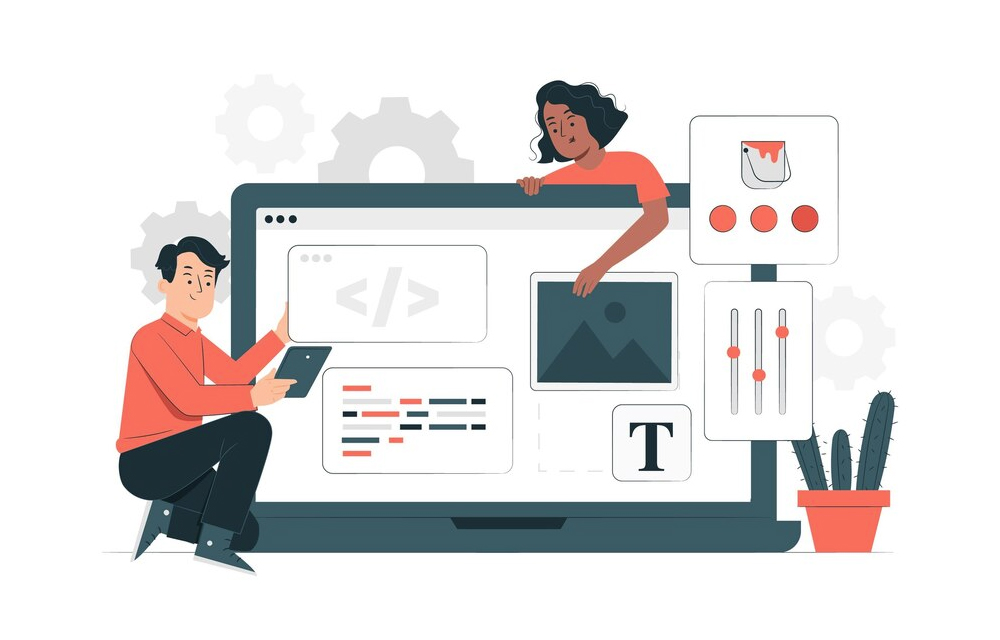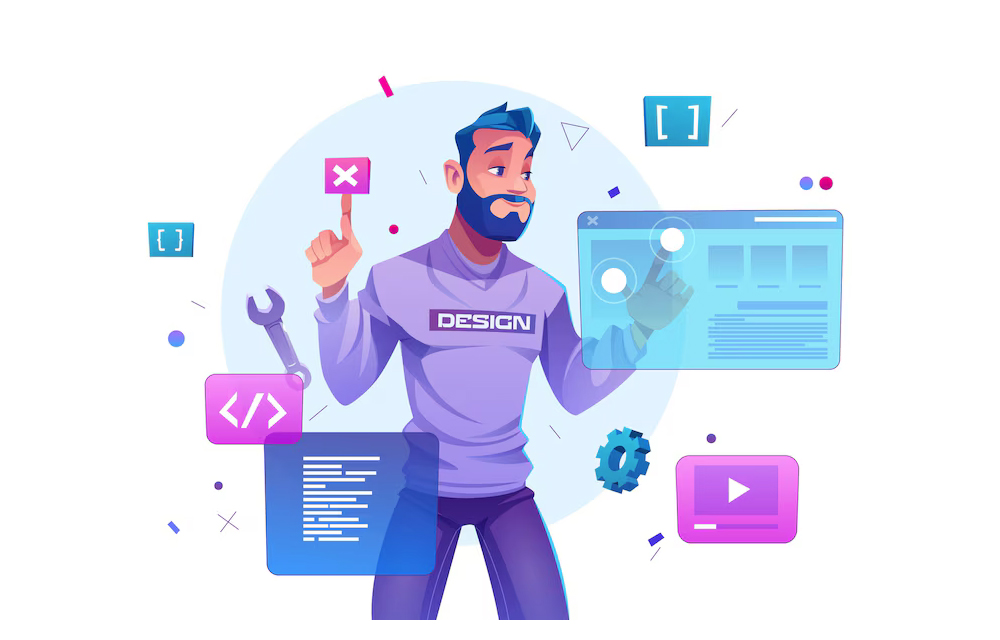It's important to acknowledge the vital role played by administrative professionals in the success of any busi...
Brickwork Blogs


Introduction
In the vast digital landscape, where attention spans are fleeting and choices abound, the design of a website is not merely an aesthetic choice; it's a strategic imperative. Your website serves as the virtual storefront, the digital handshake, and often the first point of contact between your brand and the world. In an era where online presence can make or break businesses, the importance of a well-crafted, user-centric website cannot be overstated.
The Power of First Impressions
Think about the last time you visited a website that immediately captivated you—the seamless navigation, the visually appealing layout, and the intuitive user interface. These elements are not accidental but the result of a meticulous design process. Conversely, a poorly designed website can leave visitors frustrated and inclined to abandon the site altogether. In the competitive online ecosystem, first impressions are not just valuable; they are everything.
Design as User Experience
At its core, web design goes beyond creating visually pleasing pages. It's about crafting an experience—an immersive journey that engages visitors, fulfils their needs, and leaves a lasting positive impression. The design process is the roadmap that ensures your website accomplishes these goals effectively. From understanding the purpose of your site to refining the smallest visual details, each step in the process contributes to the overall user experience.
Understanding the Purpose
To ensure a purposeful and audience-centric website design, it is crucial to first define the overarching purpose of the site, akin to setting a North Star for the design journey. This involves identifying whether the website serves as a showcase of services and information on products, portfolio showcase, informational hub, or a combination of these.
Understanding the purpose is essential for guiding design decisions and aligning every aspect of the site with its goals. A user-centric approach involves comprehending the needs and preferences of the target audience and creating detailed user personas to gain valuable insights.
Clear goals and objectives should then be set based on the defined purpose and audience, providing a roadmap that informs design decisions and guides the overall direction. Staying abreast of industry trends is crucial in the ever-evolving digital landscape; analysing competitors and identifying emerging design patterns ensures a contemporary and effective design that balances innovation with proven strategies, setting the website apart.
Visual Design
The Art of First Impressions: Aesthetic Appeal
Visual design is the soul of your website. It's the art of creating a visually appealing and cohesive aesthetic that captivates visitors from the moment they land on your site. The importance of first impressions cannot be overstated, and visual design is often the first element users encounter. A harmonious combination of colour, typography, imagery, and layout contributes to an immediate connection with your brand and message.
Color Palette and Brand Identity: Creating a Visual Language
Selecting an appropriate colour palette is not just about aesthetics—it's about conveying emotions and reinforcing brand identity. Consistency in colour usage across your website establishes a visual language that enhances recognition and brand recall. From the logo to call-to-action buttons, each colour choice plays a role in guiding the user's journey.
Typography: Balancing Readability and Personality
Typography is more than just choosing a font; it's about balancing readability with brand personality. Select fonts that align with your brand and are easy to read across various devices. Establish a hierarchy with different font weights and styles to guide users through the content. Typography contributes to the overall user experience by ensuring that information is not only accessible but also aesthetically pleasing.
Imagery and Iconography: Telling Stories through Visuals
Images and icons are powerful tools for storytelling. High-quality and relevant imagery creates an emotional connection with users, helping them relate to your brand. Consistent iconography enhances navigation and adds visual interest. Whether it's product photos, infographics, or icons, every visual element should serve a purpose in conveying information and enriching the user experience.
Layout and Consistency: Guiding the User's Eye
A well-thought-out layout is essential for guiding users through your website seamlessly. Consistency in design elements, such as headers, footers, and navigation menus, creates a sense of familiarity. Grid systems and white space contribute to a clean and organized layout, making it easier for users to find information. Visual consistency reinforces your brand identity and contributes to a polished and professional appearance.
Responsive Design: Adapting to All Screens
Responsive design is essential for accommodating various screen sizes, ensuring visual elements adapt seamlessly to desktops, tablets, and smartphones. Embracing a mobile-first approach prioritizes essential content by designing for smaller screens first. Accessibility is a fundamental aspect, adhering to Web Content Accessibility Guidelines (WCAG) for considerations like alternative text, keyboard navigation, and colour contrast. Designing for accessibility includes accommodating assistive technologies such as screen readers. Testing with these technologies ensures effective interaction for users with disabilities, enhancing overall usability. User testing, incorporating different devices and abilities, validates inclusivity and user-friendliness, gathering feedback on accessibility features and design responsiveness.
User Testing
The Crucial Feedback Loop: Introduction to User Testing
User testing is the litmus test that gauges the real-world effectiveness of your website design. While the design process involves careful planning and strategic decision-making, user testing introduces the vital element of user feedback. It's a dynamic and iterative process that involves putting your design in the hands of real users, observing their interactions, and gathering insights to refine the user experience.
Diverse User Groups: Capturing Varied Perspectives
User testing should encompass a diverse range of individuals who represent your target audience. This diversity ensures that your website caters to the needs and preferences of a broad user base. Consider factors such as age, technical proficiency, and familiarity with your industry. By capturing varied perspectives, you uncover potential usability issues that might not be apparent within a homogeneous group.
Testing Scenarios: Simulating Real-World Interactions
Define specific testing scenarios that align with the goals and objectives of your website. Whether it's completing a purchase, finding specific information, or navigating through key sections, testing scenarios simulate real-world interactions. This approach allows you to observe how users naturally engage with your website, highlighting areas of friction or confusion that might require attention.
Usability Metrics and Observations: Quantifying the User Experience
Combine qualitative and quantitative methods to evaluate the user experience. Usability metrics, such as task success rates, completion times, and error rates, provide quantitative insights into the efficiency and effectiveness of user interactions. Observational data, gathered through techniques like user interviews and session recordings, adds qualitative depth by capturing user attitudes, preferences, and pain points.
Feedback Collection: The Power of User Insights
Actively seek user feedback throughout the testing process. Encourage participants to express their thoughts, frustrations, and suggestions. This direct input provides valuable context for interpreting quantitative data and helps identify areas that may require design adjustments. Users often pinpoint issues that designers might overlook, making their insights invaluable for refining the user experience.
Iterative Design: Refining Based on User Insights
The beauty of user testing lies in its iterative nature. Once testing is complete, analyze the findings and iteratively refine the design. Address identified pain points, tweak interface elements, and optimize user flows. By integrating user feedback into the design process, you ensure that the final product is not just a reflection of your vision but a solution that aligns seamlessly with user expectations.
A/B Testing: Comparative Analysis for Continuous Improvement
Consider implementing A/B testing to compare different design variations. This method involves presenting different versions of a webpage to users and analyzing which performs better against predefined metrics. A/B testing provides data-driven insights into the effectiveness of specific design choices, allowing you to make informed decisions for continuous improvement.
Accessibility Testing: Ensuring Inclusivity
Incorporate accessibility testing within the user testing phase. Validate that the design accommodates users with varying abilities and adheres to accessibility standards. This proactive approach ensures that your website is not only visually appealing but also functional for all users.
Implementation
Translating Design into Reality: The Implementation Phase
With a meticulously planned and user-tested design in hand, the implementation phase marks the transformation of concepts into a functional and interactive website. Collaboration between designers and developers becomes paramount, as they work together to breathe life into the design. This phase involves coding, programming, and integrating various elements to ensure that the website not only looks great but also functions seamlessly.
Collaboration Between Designers and Developers: Bridging the Gap
Effective communication between designers and developers is the linchpin of successful implementation. Designers convey their vision, providing developers with detailed design specifications, assets, and guidelines. Developers, in turn, leverage their technical expertise to translate these designs into a fully functional website. Regular collaboration and feedback loops are essential to address any discrepancies between design intent and technical feasibility.
Responsive and Cross-Browser Compatibility: Ensuring Consistency Across Platforms
During implementation, it's crucial to ensure that the website maintains responsiveness and cross-browser compatibility. Developers need to optimize the code to guarantee a consistent user experience across various devices and browsers. Rigorous testing on different platforms is essential to identify and address any compatibility issues, providing a seamless experience for users, regardless of how they access the site.
Content Management System (CMS) Integration: Empowering Content Editors
For websites requiring frequent content updates, integrating a robust Content Management System (CMS) is essential. This empowers content editors to make changes easily without requiring technical expertise. Whether it's updating text, images, or adding new pages, a user-friendly CMS streamlines content management, contributing to the long-term sustainability of the website.
Performance Optimization: Speed Matters
User experience is closely tied to website performance. Optimization efforts during implementation include minimizing page load times, optimizing images, and leveraging caching mechanisms. A fast-loading website not only improves user satisfaction but also positively influences search engine rankings. Continuous monitoring and optimization are key to maintaining optimal performance as the website evolves.

Launch and Post-Launch Optimization
The Big Moment: Launching Your Website
The launch of a website is a culmination of meticulous planning, design, and implementation efforts. However, it's not the end; rather, it marks the beginning of a new phase. Before launching, conduct thorough testing to ensure that every aspect of the website functions as intended. Address any last-minute issues and confirm that all content is accurate and up to date. Consider setting up redirects if the new website replaces an existing one to preserve SEO rankings.
Post-Launch Analysis: Evaluating Initial Performance
Once the website is live, monitor its performance closely. Analytical tools provide insights into user behaviour, traffic sources, and key performance indicators. Assess whether the website is achieving its predefined goals and objectives. Pay attention to user feedback and any issues that may arise post-launch. This initial analysis lays the foundation for ongoing optimization efforts.
Iterative Improvement: Continuous Enhancement
The launch of a website doesn't signify the end of the design process; rather, it initiates a cycle of continuous improvement. Use the insights gained from post-launch analysis to identify areas for enhancement. A/B testing can be employed to compare different variations and optimize for better results. Regularly update content, address user feedback, and stay attuned to industry trends to ensure your website remains relevant and effective.
Security Measures: Safeguarding Your Digital Asset
Security is an ongoing concern in the digital landscape. Regularly update software, plugins, and frameworks to patch vulnerabilities. Implement robust security protocols, employ SSL certificates for secure data transmission, and conduct periodic security audits. A secure website not only protects user data but also enhances trust and credibility.
Scalability and Future-Proofing: Preparing for Growth
As your business evolves, so should your website. Consider scalability in terms of both content and functionality. Ensure that the website architecture can accommodate growth without sacrificing performance. Stay informed about emerging technologies and design trends, preparing your website for future updates and adaptations.
The implementation and post-launch phases are pivotal in bringing your design to life and ensuring its sustained success. By fostering collaboration, embracing performance optimization, and committing to ongoing improvement, you set the stage for a website that not only meets current expectations but evolves with the dynamic digital landscape. As we transition into these phases, let the launch be the beginning of a journey toward continuous refinement and excellence.
Conclusion
In the intricate realm of website design, where creativity meets functionality, the journey from conception to implementation is a testament to the art and science of creating a compelling online presence. As we conclude our exploration into the design process, it's evident that a well-crafted website is not merely a digital artifact; it's a dynamic entity that evolves in tandem with user expectations and technological advancements.
Also Read: The Fundamentals of UI Design: A Comprehensive Guide
How can Brickwork help you?
Brickwork’s web designers and graphics team are experts at creating websites and custom applications that are in line with your business and marketing strategy. Whether it is a B2B or B2C website and app, we ensure that your brand design creates the most impact with crisp design elements along with responsiveness and user-centric features.
Add your requirements here for anything related to design and development and mark the beginning of a digital journey with us!


